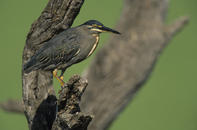
Green-backed Heron
Name
Green-backed Heron (Butorides striata)
Green-backed Heron Appearance
The green-backed heron is one of the smaller herons at around 45 cm in length. The green-backed heron has a greenish black back with distinctive grey underparts. The long bill is bicoloured, it is black on the upper mandible and yellow on the bottom mandible. This heron has a yellow eye and yellow to brown legs. During the breeding season, the eye becomes orange and the legs become orange to red.
Green-backed Heron Diet
The green-backed heron feeds on fish, frogs, and a varied range of aquatic insects. This heron is known to use bait to catch fish. They will catch a small insect, which they will float on the water to attract larger prey.
Green-backed Heron Breeding
The green-backed heron is monogamous and builds a very well hidden nest, normally placed low over the water, built out of sticks. The female lays 2 to 3 eggs and they hatch around 25 days later. Both parents share the incubation and feeding of the chicks. The chicks fledge at around 1 month later. The chicks will leave the nest and climb onto nearby branches if the nest is threatened by predators.
Green-backed Heron Behaviour
Green-backed heron are normally found solitary, foraging in the dense vegetation at the water’s edge. It is often seen in a hunched position, a crouched egg shape posture. The green-backed heron is very territorial when it comes to feeding areas.
Green-backed Heron Distribution and Habitat
In South Africa, the green-backed heron is found in the wetter western and northern areas. This heron favours fresh water that has dense vegetation overhanging the water.

